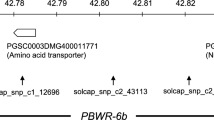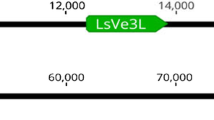Abstract
Verticillium wilt of potato is a persistent problem in the USA and worldwide. The disease, which is caused primarily by the fungus Verticillium dahliae, is difficult to manage, causes yield losses, and contaminates soil for subsequent plantings. Control strategies based on host resistance are seen as long-term, stable solutions, but difficult to achieve given the genetic nature of the host and the challenges associated with resistance evaluations. To provide breeders with marker-assisted selection opportunities, we generated a pair of cleaved amplified polymorphic sequence molecular markers within the coding region of Ve2, a potato gene with homology to the tomato Ve1 gene that confers resistance to V. dahliae. The position of the marker was determined according to the consensus sequences of Ve2 homologs of wild Solanum species with resistance to V. dahliae. Marker testing indicated their broad applicability, being able to track the resistance to V. dahliae in progeny containing genetic information derived from species S. chacoense, S. brevicaule, S. berthaultii, S. tarijense, and S. tuberosum. Furthermore, the two isolates of V. dahliae used in our inoculation experiments differed in virulence and demonstrated specificity for some wild potato species. Experimentation leading to the development of the markers and tests of their usefulness against a wide range of diploid potato germplasm is presented.



Similar content being viewed by others
References
Atallah ZK, Bae J, Jansky SH, Rouse DI, Stevenson WR (2007) Multiplex real-time quantitative PCR to detect and quantify Verticillium dahliae colonization in potato lines that differ in response to Verticillium wilt. Phytopathology 97(7):865–872
Bae J, Halterman D, Jansky SH (2008) Development of a molecular marker associated with Verticillium wilt resistance in diploid interspecific potato hybrids. Mol Breed 22:61–69
Bae J, Tai G, Jansky SH (2009) Selection for Verticillium wilt resistance in potato breeding populations derived from four cross types. Plant Breed 128(3):290–294
Bae J, Neu K, Halterman D, Jansky S (2011) Development of a potato seedling assay to screen for resistance to Verticillium dahliae. Plant Breed 130(2):225–230
Concibido VC, Secor GA, Jansky SH (1994) Evaluation of resistance to Verticillium wilt in diploid, wild potato interspecific hybrids. Euphytica 76:145–152
de Jonge R, Peter van Esse H, Maruthachalam K, Bolton MD, Santhanam P, Saber MK, Zhang Z, Usami T, Lievens B, Subbarao KV, Thomma BPHJ (2012) Tomato immune receptor Ve1 recognizes effector of multiple fungal pathogens uncovered by genome and RNA sequencing. Proc Natl Acad Sci USA 109(13):5110–5115
Diwan N, Fluhr R, Eshed Y, Zamir D, Tanksley SD (1999) Mappping of Ve in tomato: a gene conferring resistance to the broad-spectrum pathogen, Verticillium dahliae race 1. Theor Appl Genet 98:315–319
Fajardo D, Spooner DM (2011) Phylogenetic relationships of Solanum series Conicibaccata and related species in Solanum section Petota inferred from five conserved ortholog sequences. Syst Bot 36:163–170
Fradin EF, Zhang Z, Ayala JCJ, Castroverde CDM, Nazar RN, Robb J, Liu C-M, Thomma BPHJ (2009) Genetic dissection of Verticillium wilt resistance mediated by tomato Ve1. Plant Physiol 150(1):320–332
Fradin EF, Abd-El-Haliem A, Masini L, van den Berg GCM, Joosten MHAJ, Thomma BPHJ (2011) Interfamily transfer of tomato Ve1 mediates Verticillium resistance in Arabidopsis. Plant Physiol 156(4):2255–2265
Frost KE, Jansky SH, Rouse DI (2007) Consideration for Verticillium wilt resistance evaluation in potato. Plant Dis 91:360–367
Hamernik AJ, Hanneman RE, Jansky SH (2009) Introgression of wild species germplasm with extreme resistance to cold sweetening into the cultivated potato. Crop Sci 49(2):529–542
Hijmans RJ, Spooner DM (2001) Geographic distribution of wild potato species. Am J Bot 88(11):2101–2112
Jansky SH (2009) Identification of Verticillium wilt resistance in U.S. potato breeding programs. Am J Potato Res 86:502–512
Jansky SH, Rouse DI (2000) Identification of potato interspecific hybrids resistant to Verticillium wilt and determination of criteria for resistance assessment. Potato Res 43:239–251
Jansky SH, Rouse DI, Kauth PJ (2004) Inheritance of resistance to Verticillium dahliae in diploid interspecific potato hybrids. Plant Dis 88:1075–1078
Kawchuk LM, Hachey J, Lynch DR, Kulcsar F, van Rooijen G, Waterer DR, Robertson A, Kokko E, Byers R, Howard RJ, Fischer R, Prufer D (2001) Tomato Ve disease resistance genes encode cell surface-like receptors. Proc Natl Acad Sci USA 98(11):6511–6515
Larkin MA, Blackshields G, Brown NP, Chenna R, McGettigan PA, McWilliam H, Valentin F, Wallace IM, Wilm A, Lopez R, Thompson JD, Gibson TJ, Higgins DG (2007) Clustal W and Clustal X version 2.0. Bioinformatics 23(21):2947–2948
Lynch DR, Kawchuk LM, Hackey J, Bains PS, Howard RJ (1997) Identification of a gene conferring high levels of resistance to Verticillium wilt in Solanum chacoense. Plant Dis 81:1011–1014
Lynch D, Chen Q, Kawchuk L, Driedger D (2004) Verticillium wilt resistant germplasm-release of clone LRC18-21 and derivatives. Am J Potato Res 81(4):295–297
Neff MM, Turk E, Kalishman M (2002) Web-based primer design for single nucleotide polymorphism analysis. Trends Genet 18(12):613–615
Omer MA, Johnson DA, Douhan LI, Hamm PB, Rowe RC (2008) Detection, quantification, and vegetative compatibility of Verticillium dahliae in potato and mint production soils in the Columbia Basin of Oregon and Washington. Plant Dis 92(7):1127–1131
Ovchinnikova A, Krylova E, Gavrilenko T, Smekalova T, Zhuk M, Knapp S, Spooner DM (2011) Taxonomy of cultivated potatoes (Solanum section Petota: Solanaceae). Bot J Linn Soc 165:107–155
Perry JW, Evert RF (1983) Histopathology of Verticillium dahliae within mature roots of Russet Burbank potatoes. Can J Bot 61(12):3405–3421
Powelson ML, Rowe RC (1993) Biology and management of early dying of potatoes. Ann Rev Phytopathol 31:111–126
Rodriguez F, Wu F, Ané C, Tanksley S, Spooner DM (2009) Do potatoes and tomatoes have a single evolutionary history, and what proportion of the genome supports this history? BMC Evol Biol 9:191–207
Rowe RC, Powelson ML (2002) Potato early dying: management challenges in a changing production environment. Plant Dis 86:1184–1193
Rowe RC, Davis JR, Powelson ML, Rouse DI (1987) Potato early dying: causal agents and management strategies. Plant Dis 71:482–489
Schnathorst WC (1981) Life cycle and epidemiology of Verticillium. In: Mace E, Bell AA, Beckman CH (eds) Fungal wilt diseases of plants. Academic Press, San Francisco, pp 81–111
Simko I, Costanzo S, Haynes KG, Christ BJ, Jones RW (2004) Linkage disequilibrium mapping of a Verticillium dahliae resistance quantitative trait locus in tetraploid potato (Solanum tuberosum) through a candidate gene approach. Theor Appl Genet 108(2):217–224
Spooner DM, McLean K, Ramsay G, Waugh R, Bryan GJ (2005) A single domestication for potato based on multilocus amplified fragment length polymorphism genotyping. Proc Natl Acad Sci USA 102(41):14694–14699
Spooner DM, Jansky SH, Simon R (2009) Tests of taxonomic and biogeographic predictivity: resistance to disease and insect pests in wild relatives of cultivated potato. Crop Sci 49(4):1367–1376
Spooner DM, Gavrilenko T, Jansky SH, Ovchinnikova A, Krylova E, Knapp S, Simon R (2010) Ecogeography of ploidy variation in cultivated potato (Solanum sect. Petota). Am J Bot 97(12):2049–2060
Acknowledgments
Germplasm was provided by the NRSP-6 Potato Genebank. Funding was provided by an ARS-State Cooperative Potato Research Grant.
Author information
Authors and Affiliations
Corresponding author
Rights and permissions
About this article
Cite this article
Uribe, P., Jansky, S. & Halterman, D. Two CAPS markers predict Verticillium wilt resistance in wild Solanum species. Mol Breeding 33, 465–476 (2014). https://doi.org/10.1007/s11032-013-9965-2
Received:
Accepted:
Published:
Issue Date:
DOI: https://doi.org/10.1007/s11032-013-9965-2




